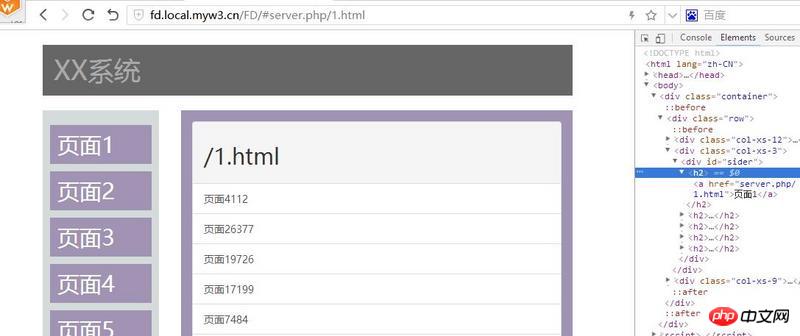
I want to make a Web client as shown in the picture. Click the navigation on the left to jump to the page on the right without refreshing.
That is, when the page on the right changes, the main routing address remains unchanged, such as index.html/# Page 1, please ask for guidance from the master, or provide study documents
Corresponds to the five navigations on the left, and five different contents can be written on the right. Click on the corresponding blocks on the left and right to display them, while other blocks are hidden. It's called tab switching.
To change the url, you can write "#block1", "#block2", etc. to the href attribute of the peripheral a tag of the left navigation.
The basic code is as follows:
<!DOCTYPE html>
<html lang="en">
<head>
<meta charset="UTF-8">
<title>Document</title>
<style>
*{
margin:0;
padding:0;
}
#nav{
float: left;
}
#nav>a{
display: block;
}
#content{
float: left;
}
#content>p{
width:500px;
height:500px;
border:1px solid #000;
display:none;
}
</style>
</head>
<body>
<p id="nav">
<a href="#block1">導(dǎo)航1</a>
<a href="#block2">導(dǎo)航2</a>
<a href="#block3">導(dǎo)航3</a>
<a href="#block4">導(dǎo)航4</a>
<a href="#block5">導(dǎo)航5</a>
</p>
<p id="content">
<p>111111111111</p>
<p>22222222222</p>
<p>33333333333</p>
<p>4444444444</p>
<p>55555555555</p>
</p>
<script>
var nav=document.getElementById('nav').getElementsByTagName('a');
var block=document.getElementById('content').getElementsByTagName('p');
for(var i=0;i<nav.length;i++){
nav[i].setAttribute("index",i);
nav[i].onclick=function(){
//右邊所有塊隱藏
for(var j=0;j<block.length;j++){
block[j].style.display="none";
}
var index=this.getAttribute("index");
//跟所點(diǎn)擊導(dǎo)航相對(duì)應(yīng)的塊顯示
block[index].style.display="block";
}
}
</script>
</body>
</html>The answers above all use tab, I don’t know if this is what the questioner wanted

Front-end (index.html):
<!DOCTYPE html>
<html lang="zh-CN">
<head>
<meta charset="utf-8">
<script src="https://cdn.bootcss.com/jquery/3.2.1/jquery.min.js"></script>
<link rel="stylesheet">
<style>
body{font-family:'Microsoft Yahei'}
#title{background:#666;color:#AAA;margin-bottom:20px;}
#title h1{padding:15px;}
#sider{background:#D5DADB;padding:10px;}
#sider h2{padding:10px;margin-top:10px;background:#A193B3;}
#sider h2 a{color:#FFF;}
#main{background:#A193B3;padding:15px;color:#FFF;min-height:400px;}
</style>
</head>
<body>
<p class="container">
<p class="row">
<p class="col-xs-12">
<p id="title">
<h1>XX系統(tǒng)</h1>
</p>
</p>
<p class="col-xs-3">
<p id="sider">
</p>
</p>
<p class="col-xs-9">
<p id="main">
請(qǐng)點(diǎn)擊左側(cè)鏈接測(cè)試
</p>
</p>
</p>
</p>
<script>
$(function(){
var load = function(url){
$('#main').load(url + '?type=ajax&time=' + (new Date()).getTime());
};
var sider = '';
for( var i = 1 ; i <= 5 ; i++ ){
sider += '<h2><a href="server.php/' + i + '.html">頁面' + i + '</a></h2>';
}
$('#sider').html(sider);
$('body').click(function(event){
if(event.target.tagName.toLowerCase() == 'a'){
var url = $(event.target).attr('href');
location.hash = url;
load(url);
return false;
}
});
if( location.hash != '' ){
load(location.hash.substr(1));
}
});
</script>
</body>
</html>Backend (server.php):
<?php
define('SUFFIX', '.html');
define('APP', 'server.php/');
$page = $_SERVER['PATH_INFO'];
if( !$page ){
$page = 'index.html';
}
if( !isset($_GET['type']) || $_GET['type'] != 'ajax' ){
//客戶直接打開時(shí),跳轉(zhuǎn)
header('Location: ../#' . $page);
die();
}
?><p class="panel panel-default">
<p class="panel-heading"><h2><?php echo $page; ?></h2></p>
<p class="list-group">
<?php
for( $i = 0 ; $i < 10 ; $i++ ){
$page_no = rand();
?> <a class="list-group-item" href="<?php echo APP . $page_no . SUFFIX; ?>">頁面<?php echo $page_no; ?></a>
<?php
}
?>
</p>
</p>No restrictions on languages ??and frameworks? Simply talking about the way to switch content without refreshing:
tab switching can be implemented simply css or using js or jq.
Update data and content without refreshing, Ajax implementation
Route jump, vue和angular等框架都可以實(shí)現(xiàn)
但是題主給的樣例是比較常見的tab切換Sample, it is still recommended to use this to achieve
It is tab switching, implemented with :target pseudo-element.
http://codepen.io/hzz/pen/RVNbyz